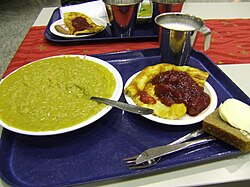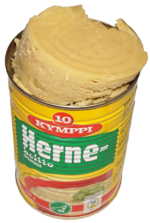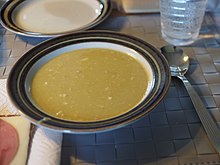Pea soup
 Finnish pea soup and pancakes served by Finnish Defence Forces | |
| Alternative names | Split pea soup |
|---|---|
| Type | Soup |
| Place of origin | Ancient Greece or Ancient Rome |
| Main ingredients | Dried peas (split pea) |
Pea soup or split pea soup is soup made typically from dried peas, such as the split pea. It is, with variations, a part of the cuisine of many cultures. It is most often greyish-green or yellow in color depending on the regional variety of peas used; all are cultivars of Pisum sativum.
History
[edit]Pea soup has been eaten since antiquity; it is mentioned in Aristophanes' The Birds, and according to one source "the Greeks and Romans were cultivating this legume about 500 BC to 400 BC. During that era, vendors in the streets of Athens were selling hot pea soup."[1]
Eating fresh "garden" peas before they were matured was a luxurious innovation of the Early Modern period:[2] by contrast with the coarse, traditional peasant fare of pease pottage (or pease porridge), Potage Saint-Germain, made of fresh peas[3] and other fresh greens braised in light stock and pureed, was an innovation sufficiently refined that it could be served to Louis XIV of France, for whose court at the Château de Saint-Germain-en-Laye it was named, c. 1660–1680.[clarification needed][4]
Around the world
[edit]Australia
[edit]
The pie floater is an Australian dish particularly common in Adelaide. It consists of a meat pie in a thick pea soup, typically with the addition of tomato sauce. Believed to have been first created in the 1890s, the pie floater gained popularity as a meal sold by South Australian pie carts.
A pie floater commonly consists of a traditional Australian-style meat pie, usually sitting, but sometimes submerged (traditionally upside down) in a bowl of thick pea soup made from blue boiler peas.[5]
Britain and Ireland
[edit]A well-known nursery rhyme, the first known written reference of which dates to 1765,[6] speaks of
Pease pudding hot,
Pease pudding cold,
Pease pudding in the pot
Nine days old;
Some like it hot,
Some like it cold,
Some like it in the pot,
Nine days old.
"Pease" is the Middle English singular and plural form of the word "pea"—indeed, "pea" began as a back-formation. Pease pudding was a high-protein, low-cost staple of the diet and, made from easily stored dried peas, was an ideal form of food for sailors, particularly boiled in accompaniment with salt pork[7] which is the origin of pea (and ham) soup. Although pease was replaced as a staple by potatoes during the nineteenth century, the food still remains popular in the national diet in the form of "mushy peas" commonly sold as the typical accompaniment to fish and chips, as well as with meat pies.
Pea soup is an English classic with many forms ranging from a thick purée, like mushy peas, to a more liquid dish. It can be made from fresh new peas or dried old peas.[8]
In 19th-century English literature, pea soup is referred to as a simple food and eating it as a sign of poverty. In the Thackeray short story "A Little Dinner at Timmins's", when a character asks his wife "Why don't you ask some of our old friends? Old Mrs. Portman has asked us twenty times, I am sure, within the last two years", she replies, with "a look of ineffable scorn", that when "the last time we went there, there was pea-soup for dinner!" In Thomas Hardy's Tess of the D'Urbervilles, Tess remarks that "we have several proofs that we are d'Urbervilles ... we have a very old silver spoon, round in the bowl like a little ladle, and marked with the same castle. But it is so worn that mother uses it to stir the pea-soup."
A soup of this sort made with yellow split-peas is called "London particular", after the thick yellow smogs for which London was famous until the Clean Air Act 1956.[9]
Canada
[edit]
Soupe aux pois (jaunes) (yellow pea soup) is a traditional dish in Québec cuisine. Traditional Québécois cuisine resembles early Maine and Vermont cuisines.[10]
One source[11] says "The most authentic version of Quebec's soupe aux pois use whole yellow peas, with salt pork, and herbs for flavour. After cooking, the pork is usually chopped and returned to the soup, or sometimes removed to slice thinly and served separately ... Newfoundland Pea Soup is very similar, but usually includes more vegetables such as diced turnips and carrots, and is often topped with small dumplings called dough boys or doughballs."
In Newfoundland, split peas are cooked in a bag as part of a Jiggs dinner, which is known as pease pudding.
Outside Francophone areas, pea soup is sometimes served with johnny cake.
Germany
[edit]
Pea soup is a common dish throughout Germany. It often contains meat such as bacon, sausage or Kassler (cured and smoked pork) depending on regional preferences. Very often, several sausages will accompany a serving of pea soup as well as some dark bread. Ready-made soup in cans is sometimes used to prepare the dish.
One of the first instant products was a pea soup product, which mainly consisted of pea meal and beef fat (Erbswurst: pea sausage). It was invented in 1867 by Johann Heinrich Grüneberg, who sold the recipe to the Prussian state. When the Franco-Prussian War broke out, the war ministry, which had previously tested the possibility of feeding soldiers solely on instant pea soup and bread, built a large manufacturing plant and produced between 4,000 and 5,000 tons of Erbswurst for the army during the war. In 1889, the Knorr instant-food company bought the license. Knorr, which is today a Unilever brand, discontinued the production of Erbswurst on December 31, 2018.[12]
Indonesia
[edit]As a former Dutch colony, Indonesia has inherited this dish as a result of Dutch–Indonesian culture, and is known as sup ercis or erwtensoep.
Netherlands
[edit]
Erwtensoep (Dutch: [ˈɛrtə(n)sup] ⓘ), also called snert (Dutch: [snɛrt] ⓘ), is the Dutch version of pea soup. It is a thick stew of green split peas, different cuts of pork, celeriac or stalk celery, onions, leeks, carrots, and often potato. Slices of rookworst (smoked sausage) are added before serving. The soup, which is traditionally eaten during the winter, is emblematic of Dutch cuisine.
It is customarily served with Frisian rye bread (roggebrood) and bacon, cheese or butter. The bacon is usually katenspek, a variety of bacon which has been cooked and then smoked. Pancakes are sometimes served with pea soup; this dish is called snert met struif, struif referring to the pancakes.
In the Royal Dutch Navy the pea soup is completed with small cubes of lard which float as white squares on top. It is therefore referred to as Snert met Drijfijs (pea soup with floating ice).
So-called koek-en-zopie outlets, small food and drinks stalls which spring up only during winters along frozen canals, ponds and lakes in the Netherlands and cater to ice skaters, usually serve snert as a savoury snack.
In Suriname, a former Dutch colony, Dutch-style pea soup is eaten as a street food.
Nordic countries
[edit]
Swedish ärtsoppa; Finnish hernekeitto [ˈherneˌkːei̯tːo]; Danish gule ærter; Norwegian ertesuppe.
Nordic pea soup is normally cooked with pork – although the meat may sometimes be served on the side – and a typical recipe would also include onions and herbs like thyme and marjoram.
In Finland the soup is made of green peas; in Sweden, Norway and Denmark yellow peas are used.
Sweden and Finland
[edit]

In Sweden and Finland the soup is usually served with mustard and chopped onion, and sometimes also with extra (dried) herbs (thyme or marjoram) to be mixed into the soup at the table. The soup is then normally followed by crêpes-like pancakes with jam (strawberry, raspberry, bilberry, cloudberry or similar) for dessert. In Sweden, the soup is sometimes accompanied by warm punsch as a special treat.
Consumption of pea soup in Sweden and Finland dates back to at least the 13th century, and is traditionally served on Thursdays. This is said to originate in the pre-Reformation era, as preparation for fasting on Fridays. The tradition of Thursday pea soup is common in restaurants, schools, military messes and field kitchens, as well as in homes, and it forms an unpretentious but well-liked part of social life. The pancakes and the punsch are a later tradition.[13]
In Finland, Laskiainen, a winter festival associated with Shrove Tuesday, is generally celebrated by eating green pea soup and either pancakes or a seasonal pastry called laskiaispulla. The celebration often includes downhill sledding.
The Swedish king Eric XIV (1533–1577) is said to have died after eating arsenic-poisoned pea soup.[14] However, it is not proven that the arsenic was added to a pea soup.[15] Pea soup is also known as one of the favorite dishes of Swedish author August Strindberg. He referred to pea soup as gudamat (food for the Gods).[16]
Denmark
[edit]In Denmark, pea soup is served with boiled pork like pork belly and medisterpølse, as well as mustard, pickled beets and rugbrød on the side. In addition, the dish is sometimes turned into a feast, with copious amounts of beer and snaps on festive occasions.[17]
In Denmark the dish can be dated to 1766 in written sources, but might have originated as early as the Bronze Age, when dried peas and cabbage became popular vegetables for the long winters there.[18][19][20]
Norway
[edit]In Norway pea soup is traditionally served at springtime and Easter, and is complemented with potatoes, carrots and vegetables.[citation needed]
Poland
[edit]
In Poland, pea soup (grochówka [ɡrɔˈxuf.ka] ⓘ) is typically associated with the military, where it still remains a popular dish. This is because pea soup is nutritious and cheap, and can be easily prepared in large quantities. It is a common saying, that military pea soup (grochówka wojskowa) must be thick enough to put a spoon straight up in it.[21] Though the pea soup is normally prepared in messes, the dish is typically associated with field kitchens. Currently, decommissioned field kitchens are often used during mass events.[22]
Ukraine
[edit]In Ukraine, where it is known as horokhovyi sup or horokhivka,[23] pea soup is a very common everyday dish. It often includes smoked meat or bacon, and is commonly served with croutons.
United States
[edit]In the United States, "pea soup" without qualification usually means a perfectly smooth puree. A recipe for "pea soup" from 1905 is made with split peas, salt pork and cold roast beef. The soup is strained through a sieve to achieve the desired texture.[24]
"Split pea soup" is a slightly thinner soup with visible peas and pieces of ham, especially popular in the Northeast, the Midwest and the Pacific Northwest. It plays a role in the light-hearted tradition of serving green-colored foods on St. Patrick's Day. For example, a 1919 Boston Globe article suggests a suitable menu for "A St. Patrick's Day Dinner" leading off with "Cream of Green Pea Soup (American Style)", and continuing with codfish croquettes with green pea sauce, lettuce salad, pistachio ice cream, and "green decorated cake".[25]
See also
[edit]References
[edit]- Baring-Gould, William. S. and Ceil Baring-Gould (1962) The Annotated Mother Goose. (Bramhall House) [Pease porridge rhyme: dates from 1765, refers to a "thin pudding."]
- ^ Zel and Reuben Allen. "Peas: History, Uses, Folklore, Growing, Nutrition, Purchasing, Preparation, Recipe: Pease Porridge Hot, Pease Porridge Cold". Vegetarians in Paradise: A Los Angeles Vegetarian Web Magazine. Archived from the original on April 27, 2012. Retrieved February 20, 2007.: "vendors in the streets of [classical] Athens were selling hot pea soup."
- ^ "Cultivated peas were mainly eaten dried in Roman and Medieval times", Maguelonne Toussaint-Samat notes (A History of Food, 2nd ed. 2009:39), giving details of the public introduction of fresh peas in their pods, coming from Genoa, at the court of Louis XIV, in January 1660.
- ^ "potage Saint-Germain is a thick purée of fresh peas" (Elizabeth Riely, The Chef's Companion: A Culinary Dictionary 2003); both directions like "Heat 3 cans of pea soup to the boiling point with a cup of heavy cream" (Louis Pullig De Gouy, The Soup Book, 1949) and references to "Saint-Germain, a western suburb of Paris" or "the Count of Saint-Germain" are in error.
- ^ Louis moved his seat permanently to Versailles in 1682.
- ^ The glorious meat pie and humble pie floater Archived 22 September 2012 at the Wayback Machine abc.net.au/sa Retrieved 2010-11-27
- ^ Clarkson, Janet (2010). Soup - A Global History. London.: Reaktion Books. pp. 88–89. ISBN 978-1-86189-774-9.
- ^ Felicity Goodall, Lost Plymouth, Hidden Heritage of the Three Towns, 2009
- ^ White, Eileen (2003). Soup. Totnes, Britain.: Prospect Books. p. 105. ISBN 1-903018-08-0.
- ^ "London particular", BBC Good Food Magazine, BBC
- ^ "Bill Brownstein: New York Times pays tribute to Canadian cuisine – starting with Joe Beef's David McMillan". montrealgazette.com. 16 January 2018.
- ^ Ferguson, Carol and Fraser, Margaret, A Century of Canadian Home Cooking: 1900 through the 90's, Prentice Hall Canada Inc., Scarborough, 1992
- ^ 3thedward (19 December 2018). "Eilmeldung Ende der Erbswurst Ende 2018". www.youtube.com/watch?v=tzyeacBEwtQ.
{{cite web}}: CS1 maint: numeric names: authors list (link) - ^ "Pea soup and pancakes – Sweden's Thursday favourite". Routes North. 10 February 2018. Retrieved 9 December 2023.
- ^ Lars Ericson in Johan III, ISBN 91-85057-47-9, p. 109
- ^ Harrison, Dick. "Ärtsoppa och arsenik". Svenska Dagbladet (in Swedish). Retrieved 9 December 2023.
- ^ "Pea soup" (PDF). American Swedish Historical Museum. Retrieved 9 December 2023.
- ^ Martin Schultz (9 September 2014). "No "Hjorddrengenes"-market without gule ærter". Lokalavisen, Norddjurs (in Danish). Politikens Lokalaviser A/S. Retrieved 11 December 2023.
- ^ "Familien Løcke". guleærter.dk (in Danish). Møllerens. Retrieved 17 October 2014.
- ^ ""Gule Ærter" - Split-Pea Soup - A Old National and Everyday Dish". Danish Food Culture. Copenhagen Portal. Archived from the original on 22 August 2015. Retrieved 17 October 2014.. Beware: This is not always a solid source.
- ^ Boyhus, Else-Marie (1996): Grøntsager – en køkkenhistorie, ISBN 87-00-23168-1 (in Danish)
- ^ Piepenbring, Dan (11 November 2013). "Happy Veterans Day! Military Food Staples That Supported the Troops' Stomachs". Bon Appétit. Retrieved 5 October 2024.
- ^ http://wiadomosci.gazeta.pl/wiadomosci/51,114912,8920098.html?i=32 Volunteers distributing pea soup during XIX. GOOC Finale
- ^ Franko, Olha. Практична кухня. — Lviv: Kamenyar, 1991. — p. 28
- ^ Mumford, Angelina Jenkins (1905). The Genesee Valley cookbook. p. 8.
- ^ "Household Department", Boston Daily Globe, March 16, 1919, p. 76
External links
[edit]- The homely fare of Sweden Detailed article about the Thursday pea soup tradition
